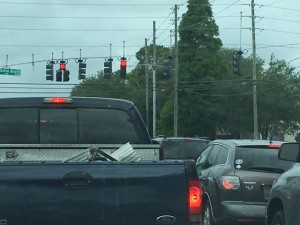 You’re stopped at a traffic light, perhaps three or four cars back. The light turns green. Three seconds pass, then four, then five.
You’re stopped at a traffic light, perhaps three or four cars back. The light turns green. Three seconds pass, then four, then five.
Finally you blast the horn, alerting the drivers in front of you who have been staring at their smart phones. If you’re lucky, they respond quickly enough so that you make it through the light, a not unreasonable expectation for someone only three or four cars back.
This happens to me at least twice a day, every day. It wasn’t that long ago that we rarely used our car horns and then only to avoid a collision. As a young adult in Virginia, I’d dutifully take my car in for an annual state inspection, part of which included honking the horn. Since, until recently, most of used our horns only a few times a year, it made sense to test the horn to prove it was in working order.
We don’t have state inspections here in Florida. Heck, we know our horns work since we use them every day to wake up other drivers so addicted to their phones that they must send a text or check email or social media at every stoplight.
If anything, we’re wearing out our horns.
This isn’t about being considerate and not wasting other people’s time. This is about safety. When your eyes are focused on anything else but traffic, even while stopped at a light, you’re a distracted driver. You’re not scanning oncoming traffic for people running red lights. You’re not noticing animals that have wandered into the street. You’re not aware of runners, cyclists, and pedestrians, a group that’s increasingly dangerous themselves since they move about distracted by their own smart phones and ear buds.
No, you’re a distracted driver, one who is going to jerk forward as soon as you hear that horn and realize you’re holding up traffic. Hopefully there’s no cyclist, runner, pedestrian, or animal nearby because you won’t see them.
Some might think using those idle moments at a stoplight to catch up on things via the phone is a wise use of time. Heck, you’re living lean, making the most of every second!
Actually, that’s not the case. Much like frequent checking of email or social media at work or at home distracts you from the task at hand and requires you to re-focus, it’s also true when behind the wheel. It also reinforces a mindset that you must be doing something and have outside stimulation at all times.
Because of smart phones, many drivers are completely unfocused while stopped at lights. I used to be one of those people. I’d save certain phone calls for when I was in the car. At least that way I wasn’t wasting time. I checked my smart phone at lights constantly. By golly, I was making the most of my time.
Then I realized I wasn’t more productive. If anything, I felt less efficient, more frazzled. That’s because I was compounding the stress of traffic with that of trying to do work. I also was setting a horrible example for our children. I couldn’t very well limit their screen time and preach the value of living in the moment, in real time rather than online, if I spent so much time on the phone – especially in the dangerous environment of driving. We’ll have a teenage driver in our home in a few years, a scary prospect in the world of distracted driving, and he is learning from me right now.
So about four years ago I put the phone away. I turned it to silent and placed it in the console between the seats. This was about the time texting became ubiquitous. Since the phone rarely rings, I no longer have to worry about missing a call. There’s no text or email that can’t wait until I’ve arrived at my destination.
Once I eliminated phone use from the car, I found myself cutting back on the radio. I’ve adopted a low-information diet, eliminating as much useless chatter from my life as possible. So there’s no need for sports talk, news talk, no morning zoo deejay nonsense or rambling traffic and weather updates, and certainly no satellite radio, which we canceled in both cars. (Sirius XM gives it away for free for a week every month or two, which seems to always coincide nicely with our long road trips.)
I can get all the news I need each morning with 30 focused minutes online and with newspapers – yes, I still read physical newspapers.
Instead of driving being stressful, it’s become relatively enjoyable. I use it as time to chat with the kids or my wife – no devices in the car – and to actually think in quiet when I’m alone.
About two years after I adopted the no-phone, low-information drive time, I was in the first car accident of my life. A careless woman, speeding in a 25 MPH zone, blew through a stop sign and T-boned me, totaling our van and leaving me with injuries I likely will deal with for life. (Thankfully I was driving alone). She was uninjured but no doubt distracted, though we’ll never know for sure since she died of unrelated causes seven months later.
Was she using a phone? Or was she like many people who have become so stressed and rushed because they must fill every waking second with some sort of digital stimulation, giving up any focus to their lives?
I’ve forgiven this woman. Dead or alive, it makes no sense to spend energy on someone who has done you wrong. But I think of her daily when I see people behind the wheel with their eyes focused downward.
Whether the car is moving or at a stoplight, it’s hazardous to all of us.
And no way to live lean.
